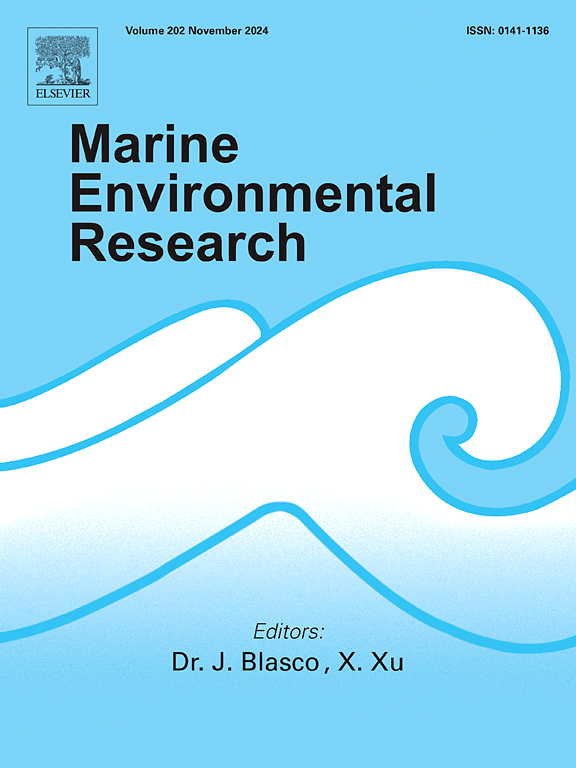Human-driven spatial and temporal contrasts in dissolved organic matter from submarine groundwater discharge and river runoff to Zhanjiang Bay, northern South China sea
IF 3.2
3区 环境科学与生态学
Q2 ENVIRONMENTAL SCIENCES
引用次数: 0
Abstract
Accurately estimating coastal carbon budgets requires a comprehensive understanding of dissolved organic matter (DOM) inputs from both groundwater discharge and river runoff, particularly in small, human-impacted tropical watersheds. This study provides a representative watershed surrounding Zhanjiang Bay in the northern South China Sea to broaden current knowledge in this field. By characterizing the spatiotemporal dynamics of water quality parameters, dissolved organic carbon (DOC), and both chromophoric and fluorescent DOM (CDOM and FDOM), we identified key patterns in DOM composition, sources, fluxes, and human-induced shifts. DOM in groundwater and river water around Zhanjiang Bay exhibited pronounced spatial heterogeneity but limited seasonal variation. Principal component and Cluster analyses identified three distinct groups. Cluster 1 represents shallow, oxygen-rich groundwater systems from cultivated land and artificial surfaces, with low DOM and microbially processed features. Cluster 2 comprises low-oxygen groundwater from grassland and wetland areas, marked by elevated DOC and humic-like FDOM, reflecting stronger terrestrial and anthropogenic inputs. Cluster 3 includes three rivers from urbanized catchments, enriched in DOC and protein-like FDOM from both anthropogenic and biological sources. Despite comparable water volumes, groundwater contributed less labile DOM flux than rivers. Riverine DOM showed a shift toward DOC-rich but CDOM-poor signature under human influence, deviating from natural tropical patterns and becoming similar to those of anthropogenically impacted rivers in northern China, indicating reduced stability and long-term carbon storage potential in marginal seas.
南海北部湛江湾海底地下水排放和河流径流中溶解有机质的时空差异
准确估算沿海碳收支需要全面了解地下水排放和河流径流的溶解有机质(DOM)输入,特别是在人类影响的小型热带流域。本研究提供了南海北部湛江湾周边具有代表性的流域,拓宽了该领域的现有知识。通过表征水质参数、溶解有机碳(DOC)、显色和荧光DOM (CDOM和FDOM)的时空动态,我们确定了DOM组成、来源、通量和人为变化的关键模式。湛江湾周边地区地下水和河流DOM具有明显的空间异质性,但季节变化有限。主成分和聚类分析确定了三个不同的群体。集群1代表来自耕地和人工地表的浅层富氧地下水系统,具有低DOM和微生物处理的特征。聚类2包括来自草地和湿地地区的低氧地下水,以DOC升高和腐殖质样FDOM为标志,反映出较强的陆地和人为输入。集群3包括三条来自城市化集水区的河流,富含来自人为和生物来源的DOC和蛋白质样FDOM。尽管水量相当,但地下水比河流贡献的不稳定DOM通量少。在人类活动的影响下,河流DOM呈现出富doc、贫cdom的特征,偏离了自然热带格局,与中国北方受人为影响的河流相似,表明边缘海的稳定性和长期碳储存潜力降低。
本文章由计算机程序翻译,如有差异,请以英文原文为准。
求助全文
约1分钟内获得全文
求助全文
来源期刊

Marine environmental research
环境科学-毒理学
CiteScore
5.90
自引率
3.00%
发文量
217
审稿时长
46 days
期刊介绍:
Marine Environmental Research publishes original research papers on chemical, physical, and biological interactions in the oceans and coastal waters. The journal serves as a forum for new information on biology, chemistry, and toxicology and syntheses that advance understanding of marine environmental processes.
Submission of multidisciplinary studies is encouraged. Studies that utilize experimental approaches to clarify the roles of anthropogenic and natural causes of changes in marine ecosystems are especially welcome, as are those studies that represent new developments of a theoretical or conceptual aspect of marine science. All papers published in this journal are reviewed by qualified peers prior to acceptance and publication. Examples of topics considered to be appropriate for the journal include, but are not limited to, the following:
– The extent, persistence, and consequences of change and the recovery from such change in natural marine systems
– The biochemical, physiological, and ecological consequences of contaminants to marine organisms and ecosystems
– The biogeochemistry of naturally occurring and anthropogenic substances
– Models that describe and predict the above processes
– Monitoring studies, to the extent that their results provide new information on functional processes
– Methodological papers describing improved quantitative techniques for the marine sciences.
 求助内容:
求助内容: 应助结果提醒方式:
应助结果提醒方式:


